Sharp R-1480, R-1482, R-1481 User Manual
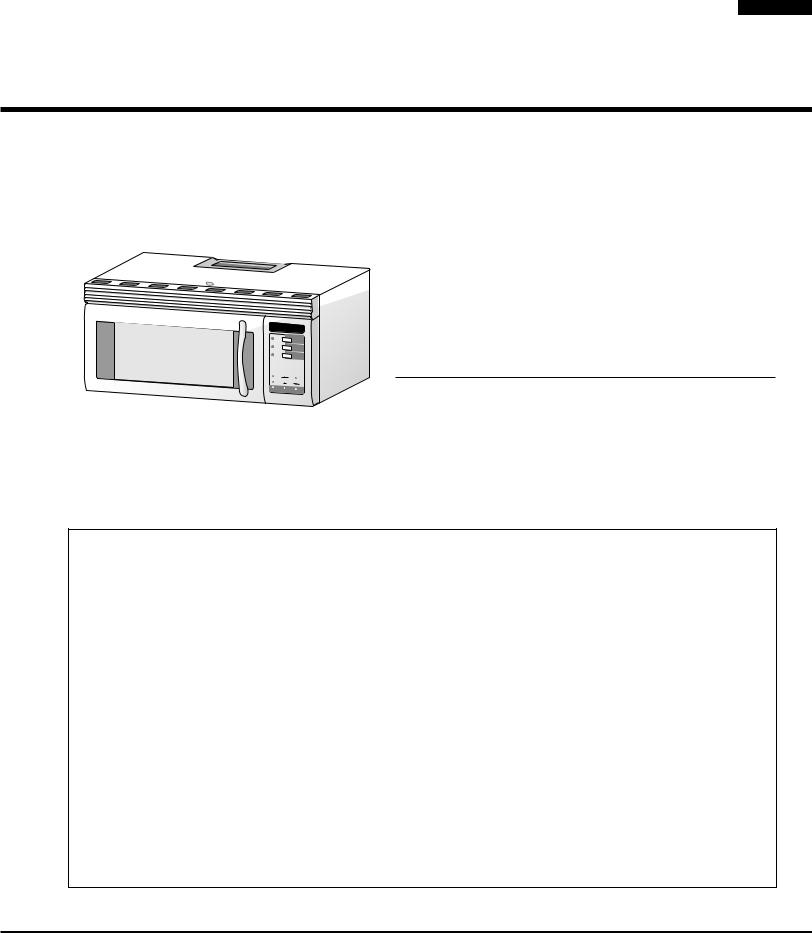
R-1480
R-1481
R-1482


 SERVICE MANUAL
SERVICE MANUAL
S3807R1480X//
OVER THE RANGE
MICROWAVE OVEN
CUSTOM HELP |
|
BREAKFAST |
|
|
POPCORN |
|
SNACKS & |
|
|
|
|
REHEAT |
|
|
COMPU DEFROST |
COMPU COOK |
|
||
1 |
2 |
3 |
4 |
5 |
|
||||
6 |
7 |
8 |
9 |
0 |
|
||||
POWER |
|
KITCHEN TIMER |
|
|
LEVEL |
|
|
MINUTE |
|
|
|
CLOCK |
|
PLUS |
TURNTABLE |
|
STOP |
|
|
ON/OFF |
|
|
START |
|
|
|
CLEAR |
|
TOUCH ON |
WORK |
|
NIGHT |
|
FAN |
LIGHT |
|
|
||
|
|
LIGHT |
|
HI/LO |
MODELS R-1480
R-1481
R-1482
In the interest of user-safety the oven should be restored to its original condition and only parts identical to those specified should be used.
WARNING TO SERVICE PERSONNEL: Microwave ovens contain circuitry capable of producing very high voltage and current, contact with following parts may result in a severe, possibly fatal, electrical shock. (High Voltage Capacitor, High Voltage Power Transformer, Magnetron, High Voltage Rectifier Assembly, High Voltage Harness etc..)
TABLE OF CONTENTS |
|
|
Page |
PRECAUTIONS TO BE OBSERVED BEFORE AND DURING SERVICING TO |
|
AVOID POSSIBLE EXPOSURE TO EXCESSIVE MICROWAVE ENERGY ................... |
INSIDE FRONT COVER |
BEFORE SERVICING ...................................................................................................... |
INSIDE FRONT COVER |
WARNING TO SERVICE PERSONNEL ................................................................................................................ |
1 |
MICROWAVE MEASUREMENT PROCEDURE ................................................................................................... |
2 |
FOREWORD AND WARNING ............................................................................................................................... |
3 |
PRODUCT SPECIFICATIONS .............................................................................................................................. |
4 |
GENERAL INFORMATION ................................................................................................................................... |
4 |
OPERATION .......................................................................................................................................................... |
6 |
TROUBLESHOOTING GUIDE ............................................................................................................................ |
11 |
TEST PROCEDURE ............................................................................................................................................ |
12 |
TOUCH CONTROL PANEL ASSEMBLY ............................................................................................................ |
21 |
COMPONENT REPLACEMENT AND ADJUSTMENT PROCEDURE ................................................................ |
26 |
PICTORIAL DIAGRAM ........................................................................................................................................ |
34 |
CONTROL PANEL CIRCUIT ............................................................................................................................... |
35 |
PRINTED WIRING BOARD ................................................................................................................................. |
36 |
PARTS LIST ........................................................................................................................................................ |
37 |
PACKING AND ACCESSORIES ......................................................................................................................... |
42 |
SHARP CORPORATION
This document has been published to be used for after sales service only.
The contents are subject to change without notice.

R-1480
R-1481
R-1482
PRECAUTIONS TO BE OBSERVED BEFORE AND DURING SERVICING TO AVOID POSSIBLE EXPOSURE TO EXCESSIVE MICROWAVE ENERGY
(a)Do not operate or allow the oven to be operated with the door open.
(b)Make the following safety checks on all ovens to be serviced before activating the magnetron or other microwave source, and make repairs as necessary: (1) interlock operation, (2) proper door closing, (3) seal and sealing surfaces (arcing, wear, and other damage), (4) damage to or loosening of hinges and latches, (5) evidence of dropping or abuse.
(c)Before turning on microwave power for any service test or inspection within the microwave generating compartments, check the magnetron, wave guide or transmission line, and cavity for proper alignment, integrity, and connections.
(d)Any defective or misadjusted components in the interlock, monitor, door seal, and microwave generation and transmission systems shall be repaired, replaced, or adjusted by procedures described in this manual before the oven is released to the owner.
(e)A microwave leakage check to verify compliance with the Federal Performance Standard should be performed on each oven prior to releasing oven to the owner.
BEFORE SERVICING
Before servicing an operative unit, perform a microwave emission check as per the Microwave Measurement Procedure outlined in this service manual.
If microwave emissions level is in excess of the specified limit, contact SHARP ELECTRONICS CORPORATION immediately @1-800-237-4277.
If the unit operates with the door open, service person should 1) tell the user not to operate the oven and 2) contact SHARP ELECTRONICS CORPORATION and Food and Drug Administration's Center for Devices and Radiological Health immediately.
Service personnel should inform SHARP ELECTRONICS CORPORATION of any certified unit found with emissions in excess of 4mW/cm2. The owner of the unit should be instructed not to use the unit until the oven has been brought into compliance.
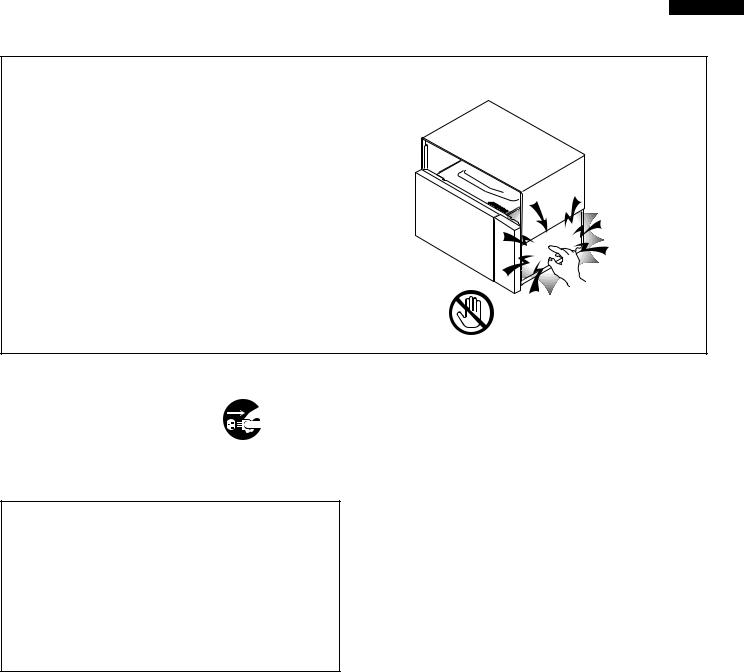
R-1480
R-1481
R-1482
WARNING TO SERVICE PERSONNEL
Microwave ovens contain circuitry capable of producing very high voltage and current, contact with following parts may result in a severe, possibly fatal, electrical shock.
(Example)
High Voltage Capacitor, High Voltage Power Transformer, Magnetron, High Voltage Rectifier Assem-
bly, High Voltage Harness etc.. Read the Service Manual carefully and follow all
instructions.
Don't Touch ! Danger High Voltage
Before Servicing
1. Disconnect the power supply cord |
, and then |
remove outer case. |
|
2.Open the door and block it open.
3.Discharge high voltage capacitor.
WARNING:RISK OF ELECTRIC SHOCK. DISCHARGE THE HIGH-VOLTAGE CAPACITOR BEFORE SERVICING.
The high-voltage capacitor remains charged about 60 seconds after the oven has been switched off. Wait for 60 seconds and then short-circuit the connection of the highvoltage capacitor (that is the connecting lead of the highvoltage rectifier) against the chassis with the use of an insulated screwdriver.
Whenever troubleshooting is performed the power supply must be disconnected. It may in, some cases, be necessary to connect the power supply after the outer case has been removed, in this event,
1.Disconnect the power supply cord, and then remove outer case.
2.Open the door and block it open.
3.Discharge high voltage capacitor.
4.Disconnect the leads to the primary of the power transformer.
5.Ensure that these leads remain isolated from other components and oven chassis by using insulation tape.
6.After that procedure, reconnect the power supply cord.
When the testing is completed,
1.Disconnect the power supply cord, and then remove outer case.
2.Open the door and block it open.
3.Discharge high voltage capacitor.
4.Reconnect the leads to the primary of the power transformer.
5.Reinstall the outer case (cabinet).
6.Reconnect the power supply cord after the outer case is installed.
7.Run the oven and check all functions.
After repairing
1.Reconnect all leads removed from components during testing.
2.Reinstall the outer case (cabinet).
3.Reconnect the power supply cord after the outer case is installed.
4.Run the oven and check all functions.
Microwave ovens should not be run empty. To test for the presence of microwave energy within a cavity, place a cup of cold water on the oven turntable, close the door and set the power to HIGH and set the microwave timer for two (2) minutes. When the two minutes has elapsed (timer at zero) carefully check that the water is now hot. If the water remains cold carry out Before Servicing procedure and reexamine the connections to the component being tested.
When all service work is completed and the oven is fully assembled, the microwave power output should be checked and microwave leakage test should be carried out.
1

R-1480
R-1481
R-1482
MICROWAVE MEASUREMENT PROCEDURE
A. Requirements:
1)Microwave leakage limit (Power density limit): The power density of microwave radiation emitted by a microwave oven should not exceed 1mW/cm2 at any point 5cm or more from the external surface of the oven, measured prior to acquisition by a purchaser, and thereafter (through the useful life of the oven), 5 mW/cm2 at any point 5cm or more from the external surface of the oven.
2)Safety interlock switches Primary interlock relay and door sensing switch shall prevent microwave radiation emission in excess of the requirement as above mentioned, secondary interlock switch shall prevent microwave radiation emission in excess of 5 mW/cm2 at any point 5cm or more from the external surface of the oven.
B. Preparation for testing:
Before beginning the actual measurement of leakage, proceed as follows:
1)Make sure that the actual instrument is operating normally as specified in its instruction booklet.
Important:
Survey instruments that comply with the requirement for instrumentation as prescribed by the performance standard for microwave ovens, 21 CFR 1030.10(c)(3)(i), must be used for testing.
2)Place the oven tray in the oven cavity.
3)Place the load of 275±15 ml (9.8 oz) of tap water initially at 20±5˚C (68˚F) in the center of the oven cavity.
The water container shall be a low form of 600 ml (20 oz) beaker with an inside diameter of approx. 8.5 cm (3-1/2 in.) and made of an electrically nonconductive material such as glass or plastic.
The placing of this standard load in the oven is important not only to protect the oven, but also to insure that any leakage is measured accurately.
4)Set the cooking control on Full Power Cooking Mode
5)Close the door and select a cook cycle of several minutes. If the water begins to boil before the survey is completed, replace it with 275 ml of cool water.
C. Leakage test:
Closed-door leakage test (microwave measurement)
1)Grasp the probe of the survey instrument and hold it perpendicular to the gap between the door and the body of the oven.
2)Move the probe slowly, not faster than 1 in./sec. (2.5 cm/sec.) along the gap, watching for the maximum indication on the meter.
3)Check for leakage at the door screen, sheet metal seams and other accessible positions where the continuity of the metal has been breached (eg., around the switches, indicator, and vents).
While testing for leakage around the door pull the door away from the front of the oven as far as is permitted by the closed latch assembly.
4)Measure carefully at the point of highest leakage and make sure that the highest leakage is no greater than 4mW/cm2, and that the secondary interlock switch does turn the oven OFF before any door movement.
NOTE: After servicing, record data on service invoice and microwave leakage report.
2
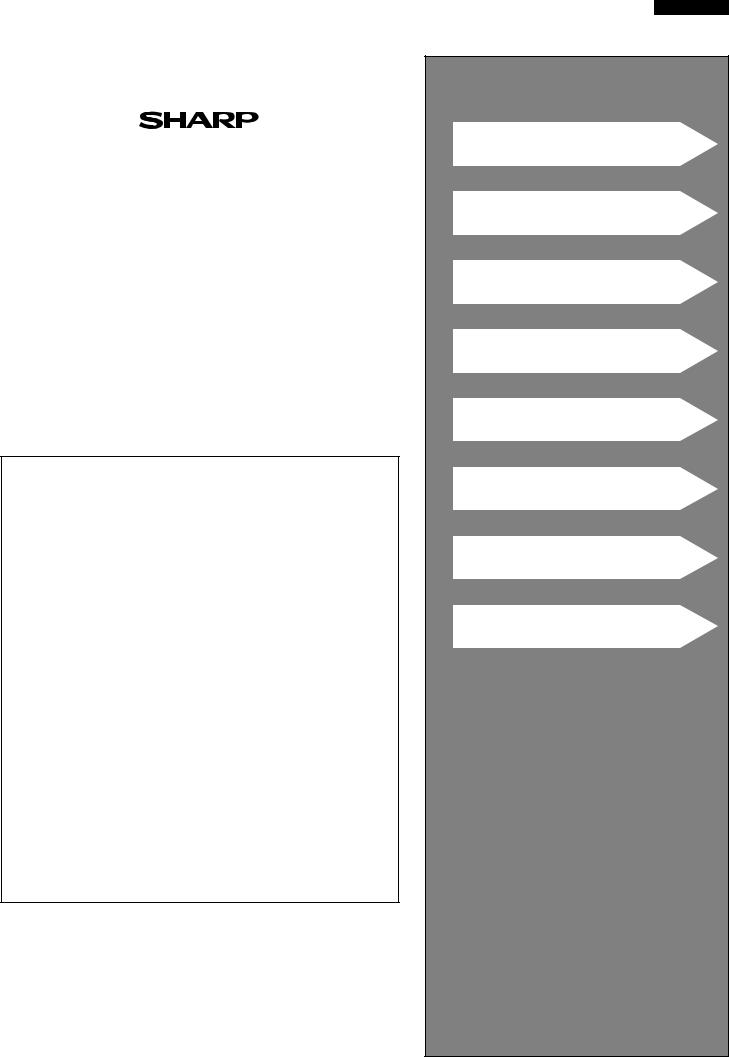
SERVICE MANUAL
OVER THE RANGE
MICROWAVE OVEN
R-1480 / R-1481 / R-1482
FOREWORD
This Manual has been prepared to provide Sharp Electronics Corp. Service Personnel with Operation and Service Information for the SHARP OVER THE RANGE MICROWAVE OVEN, R-1480, R-1481, R-1482.
It is recommended that service personnel carefully study the entire text of this manual so that they will be qualified to render satisfactory customer service.
Check the interlock switches and the door seal carefully. Special attention should be given to avoid electrical shock and microwave radiation hazard.
WARNING
Never operate the oven until the following points are ensured.
(A)The door is tightly closed.
(B)The door brackets and hinges are not defective.
(C)The door packing is not damaged.
(D)The door is not deformed or warped.
(E)There is not any other visible damage with the oven.
Servicing and repair work must be carried out only by trained service personnel.
DANGER
Certain initial parts are intentionally not grounded and present a risk of electrical shock only during servicing. Service personnel - Do not contact the following parts while the appliance is energized;
High Voltage Capacitor, Power Transformer, Magnetron, High Voltage Rectifier Assembly, High Voltage Harness;
If provided, Vent Hood, Fan assembly, Cooling Fan Motor.
All the parts marked “*” on parts list are used at voltages more than 250V.
Removal of the outer wrap gives access to voltage above 250V.
All the parts marked “ ” on parts list may cause undue microwave exposure, by themselves, or when they are damaged, loosened or removed.
SHARP ELECTRONICS CORPORATION
SHARP PLAZA, MAHWAH,
NEW JERSEY 07430-2135
3
R-1480
R-1481
R-1482
PRODUCT DESCRIPTION
GENERAL INFORMATION
OPERATION
TROUBLESHOOTING GUIDE AND TEST PROCEDURE
TOUCH CONTROL PANEL
COMPONENT REPLACEMENT AND ADJUSTMENT PROCEDURE
WIRING DIAGRAM
PARTS LIST

R-1480
R-1481
R-1482
PRODUCT SPECIFICATION
ITEM |
|
DESCRIPTION |
|
|
|
Power Requirements |
120 Volts / 14.3 Amperes |
|
|
60 Hertz |
|
|
Single phase, 3 wire grounded |
|
|
|
|
Power Output |
950 watts (IEC-705 TEST PROCEDURE) |
|
|
Operating frequency of 2450MHz |
|
|
|
|
Convection Power Output |
1700 watts |
|
|
|
|
Case Dimensions |
Width 29-15/16" |
|
|
Height 16-3/8" |
|
|
Depth 15- 1/4" (Not including the door handle) |
|
|
|
|
Cooking Cavity Dimensions |
Width 20-1/4" |
|
|
Height 8-3/16" |
|
1.4 Cubic Feet |
Depth 14-1/2" |
|
|
|
|
Hood lamp |
2 bulbs, 30W x 2, |
Incandescent light bulbs |
|
|
|
Hood fan |
Approx. 300 C.F.M. |
|
|
|
|
Control Complement |
Touch Control System |
|
|
Clock ( 1:00 - 12:59 ) |
|
|
Timer (0 - 99 min. 99 seconds) |
|
|
Microwave Power for Variable Cooking |
|
|
Repetition Rate; |
|
|
P-HI .................................................. |
Full power throughout the cooking time |
|
P-90 .................................................................... |
approx. 90% of Full Power |
|
P-80 .................................................................... |
approx. 80% of Full Power |
|
P-70 .................................................................... |
approx. 70% of Full Power |
|
P-60 .................................................................... |
approx. 60% of Full Power |
|
P-50 .................................................................... |
approx. 50% of Full Power |
|
P-40 .................................................................... |
approx. 40% of Full Power |
|
P-30 .................................................................... |
approx. 30% of Full Power |
|
P-20 .................................................................... |
approx. 20% of Full Power |
|
P-10 .................................................................... |
approx. 10% of Full Power |
|
P-0 .................................................... |
No power throughout the cooking time |
|
CUSTOM HELP pad, BREAKFAST pad, POPCORN pad, |
|
|
SNACKS & REHEAT pad, COMPU DEFROST pad, COMPU COOK pad, |
|
|
Number selection pads, POWER LEVEL pad, KITCHEN TIMER / CLOCK pad |
|
|
MINUTE PLUS pad, TURNTABLE ON / OFF pad, START / TOUCH ON pad |
|
|
WORK LIGHT pad, NIGHT LIGHT pad, FAN HI / LO pad |
|
|
|
|
Oven Cavity Light |
30W x 1 Incandescent light bulb |
|
|
|
|
Safety Standard |
UL Listed |
FCC Authorized |
|
DHHS Rules, CFR, Title 21, Chapter 1, Subchapter J |
|
|
|
|
Weight |
Approx. 55 lbs. |
|
|
|
|
GENERAL INFORMATION
GROUNDING INSTRUCTIONS
This oven is equipped with a three prong grounding plug. It must be plugged into a wall receptacle that is properly installed and grounded in accordance with the National Electrical Code and local codes and ordinances.
In the event of an electrical short circuit, grounding reduces the risk of electric shock by providing an escape wire for the electric current.
WARNING: Improper use of the grounding plug can result in a risk of electric shock.
4
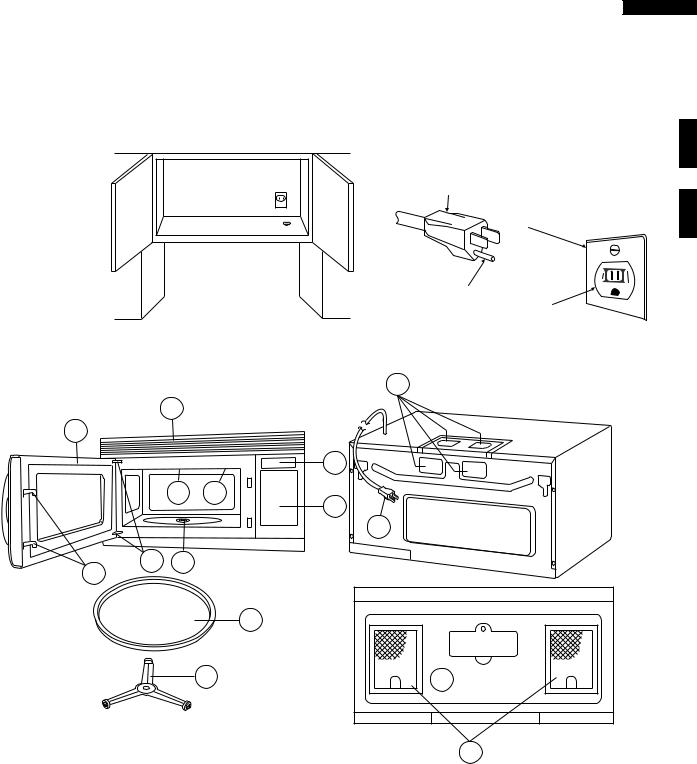
R-1480
R-1481
R-1482
Electrical Requirements
The oven is equipped with a 3-prong grounding plug. DO NOT UNDER ANY CIRCUMSTANCES CUT OR REMOVE THE GROUNDING PIN FROM THE PLUG.
The power supply cord and plug must be connected to a separate 120 Volt AC, 60 Hz, 15 Amp. or more branch circuit, using a grounded receptacle. The receptacle should be located inside the cabinet directly above the Microwave Oven/Hood system mounting location.
3-Pronged Plug
Grounded
Receptacle Box
|
|
|
Grounding Pin |
|
|
|
3-Pronged Receptacle |
|
|
|
OVEN DIAGRAM |
|
|
|
9 |
|
9 |
|
|
1 |
|
|
|
|
|
|
8 |
|
3 |
5 |
7 |
|
|
|
|
|
|
|
14 |
2 |
4 |
|
|
6 |
|
|
|
|
|
|
12 |
|
|
13 |
10 |
|
|
|
11 |
1.Oven door with see-through window.
2.Door hinges.
3.Stirrer cover.
4.Turntable motor shaft.
5.Oven lamp.
It will light when oven is operating or door is open.
6.Door latches.
The oven will not operate unless the door is securely closed.
7.Auto-Touch control panel.
8.Time display: Digital display, 99 minutes 99 seconds.
9.Ventilation openings.
10.Light Cover.
11.Grease filters.
12.Removable turntable.
The turntable will rotate clockwise or counterclockwise. Only remove for cleaning.
13.Removable turntable support.
14.Power supply cord
5
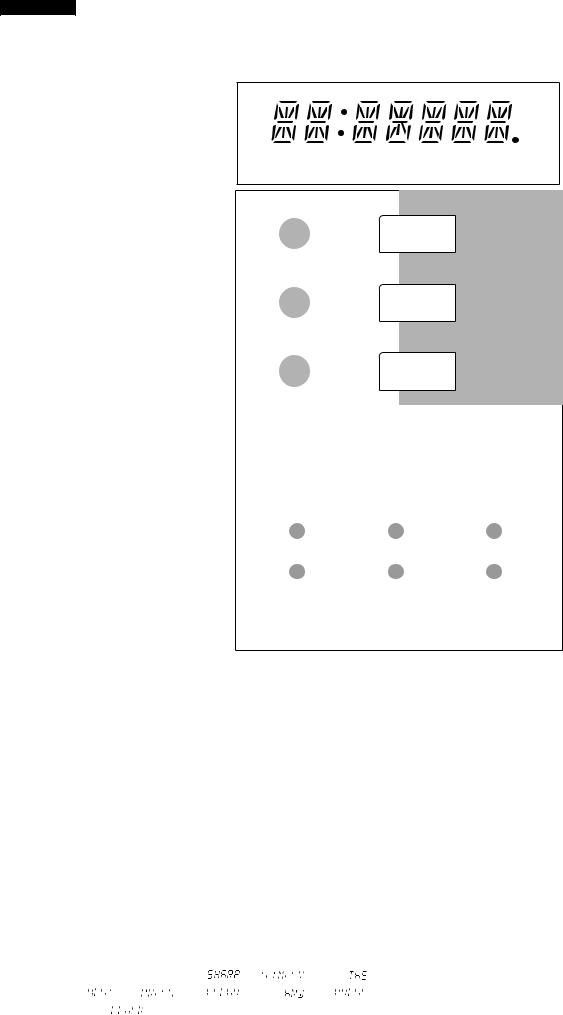
R-1480
R-1481
R-1482
CONTROL PANEL
MIX CONV COOK LBS KG TURNTABLE OFF HELP
1 Coffee/tea
2 Roll/muffin, fresh CUSTOM HELP BREAKFAST 3 Roll/muffin, frozen
4 Hot cereal
5 Scrambled eggs
POPCORN |
SNACKS & |
|
REHEAT |
||
|
||
COMPU DEFROST |
COMPU COOK |
1 Dinner plate
2Pasta/casserole
3Frozen entree
4Frozen snack
5Pizza, slice
1 Baked potatoes
2 Fresh vegetables
3 Frozen vegetables
4Rice
5Ground meat
1 |
2 |
3 |
|
4 |
5 |
||
6 |
7 |
8 |
|
9 |
0 |
||
POWER |
|
KITCHEN TIMER |
|
MINUTE |
|||
LEVEL |
|
|
CLOCK |
|
PLUS |
||
TURNTABLE |
|
|
STOP |
|
START |
||
ON/OFF |
|
|
CLEAR |
|
|
TOUCH ON |
|
|
|
|
|
|
|
|
|
WORK |
|
|
NIGHT |
|
FAN |
||
LIGHT |
|
|
LIGHT |
|
HI/LO |
||
|
|
|
|
|
|
|
|
OPERATION
DESCRIPTION OF OPERATING SEQUENCE
The following is a description of component functions during oven operation.
OFF CONDITION
Closing the door activates the door sensing switch and secondary interlock switch. (In this condition, the monitor switch contacts are opened.)
When oven is plugged in, 120 volts A.C. is supplied to the control unit. (Figure O-1).
1. The display will show |
|
, |
|
, |
|
, |
||||||
|
|
|
||||||||||
|
|
|
, |
|
|
, |
|
, |
|
, |
|
|
|
and |
|
|
. |
|
|
|
|
|
|
|
|
|
|
|
|
|
|
|
|
|
|
|
||
To set any program or set the clock, you must first touch the STOP/CLEAR pad. The display will clear, and " : " will appear .
COOKING CONDITION
Program desired cooking time touching the NUMBER pads. When the START pad is touched, the following operations occur:
1.The contacts of relays are closed and components connected to the relays are turned on as follows.
(For details, refer to Figure O-2)
6

RELAY |
CONNECTED COMPONENTS |
RY1 |
Oven lamp / Fan motor / Stirrer motor |
|
|
RY2 |
Power transformer |
|
|
RY3 |
Turntable motor |
|
|
RY4 |
Hood fan motor |
2.120 volts A.C. is supplied to the primary winding of the power transformer and is converted to about 3.3 volts A.C. output on the filament winding, and approximately 2000 volts A.C. on the high voltage winding.
3.The filament winding voltage heats the magnetron filament and the H.V. winding voltage is sent to a voltage doubler circuit.
4.The microwave energy produced by the magnetron is channelled through the waveguide into the cavity feedbox, and then into the cavity where the food is placed to be cooked.
5.Upon completion of the cooking time, the power transformer, oven lamp, etc. are turned off, and the generation of microwave energy is stopped. The oven will revert to the OFF condition.
6.When the door is opened during a cook cycle, monitor switch, door sensing switch, secondary interlock switch and primary interlock relay are activated with the following results. The circuits to the stirrer motor, the cooling fan motor, the turntable motor, and the high voltage components are de-energized, and the digital read-out displays the time still remaining in the cook cycle when the door was opened.
7.The monitor switch is electrically monitoring the operation of the secondary interlock switch and primary interlock relay (RY2) and is mechanically associated with the door so that it will function in the following sequence.
(1)When the door opens from a closed position, the primary interlock relay and secondary interlock switch open their contacts, and then the monitor switch contacts close.
(2)When the door is closed from the open position, the monitor switch contacts first open, and then the contacts of the secondary interlock switch and door sensing switch close.
If the secondary interlock switch and primary interlock relay (RY2) fail with their contacts closed when the door is opened, the closing of the monitor switch contacts will form a short circuit through the monitor fuse, secondary interlock switch and primary interlock relay (RY2), causing the monitor fuse to blow.
POWER LEVEL P-0 TO P-90 COOKING
When Variable Cooking Power is programmed, the 120 volts A.C. is supplied to the power transformer intermittently through the contacts of relay (RY2) which is operated by the control unit within an interval second time base. Microwave power operation is as follows:
|
|
|
|
|
|
|
|
|
R-1480 |
||
|
|
|
R-1481 |
||
|
|
|
R-1482 |
||
|
|
|
|
|
|
VARI-MODE |
ON TIME |
OFF TIME |
|
||
Power 10(P-HI) |
32 sec. |
0 sec. |
|||
(100% power) |
|
|
|
|
|
|
|
|
|
|
|
Power 9(P-90) |
30 sec. |
2 sec. |
|||
(approx. 90% power) |
|
|
|
|
|
|
|
|
|
|
|
Power 8(P-80) |
26 sec. |
6 sec. |
|||
(approx. 80% power) |
|
|
|
|
|
|
|
|
|
|
|
Power 7(P-70) |
24 sec. |
8 sec. |
|
|
|
(approx. 70% power) |
|
|
|
|
|
|
|
|
|
|
|
Power 6(P-60) |
22 sec. |
10 sec. |
|
||
|
|||||
(approx. 60% power) |
|
|
|
|
|
|
|
|
|
||
Power 5(P-50) |
18 sec. |
14 sec. |
|
||
(approx. 50% power) |
|
|
|
|
|
|
|
|
|
|
|
Power 4(P-40) |
16 sec. |
16 sec. |
|
||
|
|||||
(approx. 40% power) |
|
|
|
|
|
|
|
|
|
|
|
Power 3(P-30) |
12 sec. |
20 sec. |
|||
(approx. 30% power) |
|
|
|
|
|
|
|
|
|
|
|
Power 2(P-20) |
8 sec. |
24 sec. |
|||
(approx. 20% power) |
|
|
|
|
|
|
|
|
|
|
|
Power 1(P-10) |
6 sec. |
26 sec. |
|||
(approx. 10% power) |
|
|
|
|
|
|
|
|
|
|
|
Power 0(P-0) |
0 sec. |
32 sec. |
|||
(0% power) |
|
|
|
|
|
Note: The ON/OFF time ratio does not correspond with the percentage of microwave power, because approx. 2 seconds are needed for heating of the magnetron filament.
COMPU COOK
COMPU COOK will automatically compute the microwave power and cooking time. Set the desired program by touching one of the COMPU COOK pad, and number pad to select menu. Enter the weight or quantity by touching the Number pads. When the START pad is touched, the following operations occur:
1.The COOK indicator will light.
2.The cooking time will appear on the display and start counting down to zero. The cooking time is adjusted automatically according to the weight of the food.
3.The shut-off relays (RY1, RY2 and RY3) are energized, turning on the oven lamp, turntable motor, cooling fan motor and convection motor. The power supply voltage is applied to the heating element.
4.Now, the oven is in the microwave cooking mode.
COMPU DEFROST COOKING
The COMPU DEFROST key is a special function key to defrost meats and poultry faster and better. COMPU DEFROST automatically defrosts roast beef, etc.. Touch the COMPU COOK pad and number pad to select menu and enter the food weight by touching the number pads. When the START pad is touched, the oven will cook according to the special cooking sequence.
7
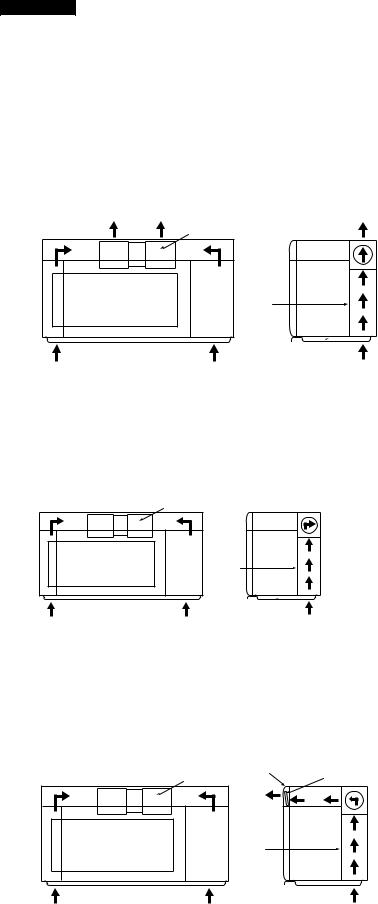
R-1480
R-1481
R-1482
VENTILATION METHODS HOT AIR EXHAUST
1.VERTICAL VENTING
For this venting method, hot air rising from the conventional range below is drawn in by the hood fan motor through the grease filters at the right and left sides of the base cover, up through the right and left sides of the oven cavity, then discharged vertically at rear center top of the oven, into the customer's vent system.
_: AIR FLOW
TO DUCT |
TO DUCT |
HOOD FAN MOTOR
HOOD
INTAKE
DUCT
GREASE 
FILTER
2.HORIZONTAL VENTING
The air handing is the same as VERTICAL VENTING except that the final air discharge is directed horizontally out from the top rear of the oven into the customer's vent system.
_: AIR FLOW
HOOD FAN MOTOR
 TO DUCT
TO DUCT
HOOD
INTAKE
DUCT
GREASE 
FILTER
3.RE-CIRCULATION (INSIDE VENTING)
The air handing is the same as VERTICAL VENTING except that the final air discharge is directed horizontally through the upper front of the oven into the kitchen. IN this case, the accessory charcoal filter RK-230 must be provided to filter the air before it leaves the oven.
_: AIR FLOW
|
HOOD EXHAUST |
CHARCOAL |
HOOD FAN MOTOR |
LOUVER |
FILTER |
HOOD |
INTAKE |
DUCT |
8
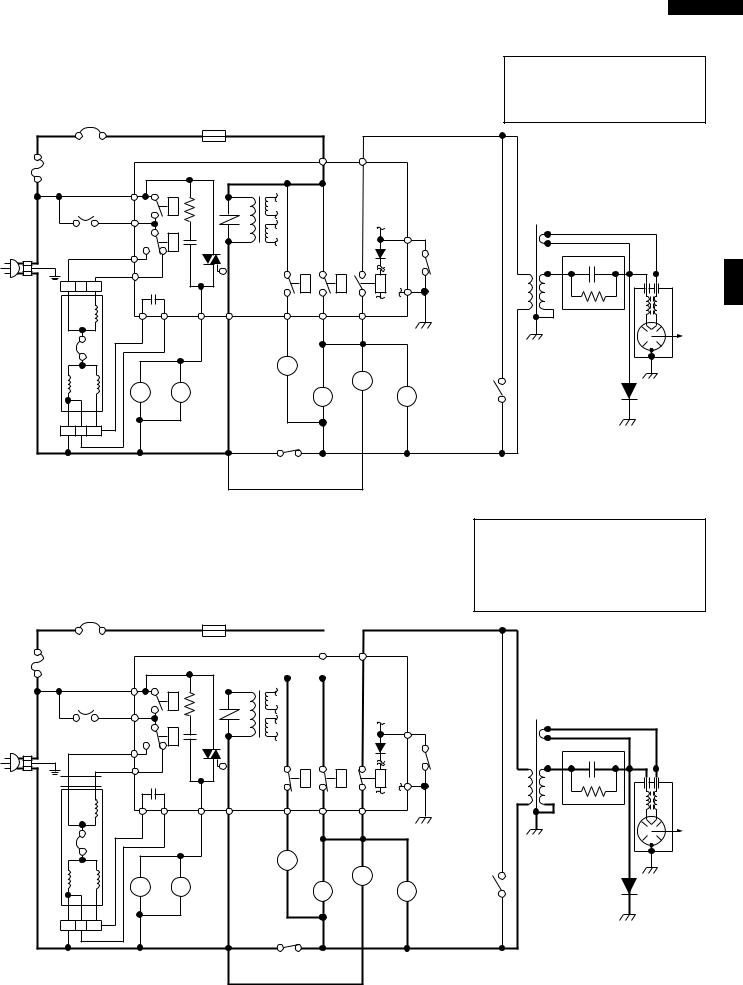
CAVITY |
MAGNETRON |
THERMAL CUT-OUT |
TEMPERATURE FUSE |
R-1480
R-1481
R-1482
SCHEMATIC NOTE: CONDITION OF OVEN
1.DOOR CLOSED
2.CLOCK APPEARS ON DISPLAY
|
|
|
|
|
|
CONTROL UNIT |
|
|
COM. |
|
N.O. |
|
|
|
|
|
|
|
FUSE |
|
|
|
|
|
|
|
|
|
|
|
|
|
|
|
|
|
|
20A |
|
|
|
|
|
|
|
|
|
|
|
PRIMARY INTERLOCK RELAY |
|
|
|
|
|
|
|
|
B7 |
|
RY4 |
|
|
|
|
|
|
|
|
|
|
|
|
||
|
|
|
|
|
|
|
|
|
|
|
|
|
|
|
|
|
||
|
|
|
|
|
|
|
|
|
|
|
|
|
|
|
|
|
POWER |
|
|
|
B5 |
|
|
|
|
|
|
|
|
|
|
|
|
|
|
TRANSFORMER |
|
|
|
|
|
|
|
|
|
|
|
|
|
|
|
|
|
|
|
|
BLK |
HOOD FAN |
|
|
RY5 |
|
|
|
|
|
|
|
|
|
E1 |
|
|
|
|
|
|
|
SSR |
|
|
|
|
|
|
|
|
|
|
|
|
|||
THERMAL |
|
High |
|
|
|
|
|
|
|
|
|
|
|
|
|
|
||
CUT OUT |
B3 |
N.C. |
|
|
|
|
|
|
|
|
|
|
|
|
|
|||
GRN |
|
|
|
|
|
|
|
|
|
|
|
|
|
|
|
|
||
|
|
|
|
|
|
|
|
|
|
|
|
|
DOOR |
|
|
|
||
|
|
|
|
|
|
|
|
|
|
|
|
|
|
|
|
|
||
WHT |
|
B1 |
Low |
|
|
|
|
|
|
|
|
|
|
|
SENSING |
|
|
MAGNETRON |
|
|
HOOD |
|
|
|
|
|
|
|
|
|
|
E2 |
SWITCH |
|
|
||
120 V AC. GND |
|
|
|
|
|
|
|
|
|
|
|
|
|
|
|
|||
|
|
|
|
|
|
|
|
|
|
|
|
|
|
|
|
|||
|
|
CAPACITOR |
|
|
|
|
|
|
|
|
|
|
|
|
|
|
||
60 Hz |
|
|
|
|
|
|
RY3 |
|
|
RY1 |
|
RY2 |
|
|
|
|
|
|
|
|
|
|
|
|
|
|
|
|
|
|
|
|
|
||||
|
|
HOOD |
A1 |
A3 |
B9 |
A7 |
A5 |
|
N.O. |
COM. |
|
|
|
|
HIGH VOLTAGE |
|
||
|
|
MOTOR |
|
|
|
|
|
|
|
|
|
|
|
|
|
CAPACITOR |
|
|
|
|
|
|
|
|
TURNTABLE MOTOR |
FAN MOTOR |
|
|
LAMPOVEN |
|
STIRRER |
MOTOR |
|
|
MONITOR SWITCH |
0.94 F |
|
|
|
|
|
|
|
|
|
|
|
|
|
|
||||||
|
|
|
HOOD |
|
TTM |
|
|
|
|
|
|
|
|
|
|
|
||
|
|
|
|
|
|
|
|
|
|
|
|
|
|
|
|
|
||
|
|
|
LAMP |
|
|
|
|
|
|
OL |
|
|
|
|
|
|
|
|
|
|
|
HL |
HL |
|
|
|
FM |
|
|
|
|
STM |
|
|
HIGH VOLTAGE |
|
|
|
|
|
|
|
|
|
|
|
|
|
|
|
|
RECTIFIER |
|
|||
|
|
|
|
|
|
|
|
|
|
|
|
|
|
|
|
|
|
|
|
|
|
|
|
|
SECONDARY |
|
|
|
|
|
|
|
|
|
|
||
|
|
|
|
|
|
INTERLOCK |
|
|
|
|
|
|
|
|
|
|
||
|
|
|
|
|
|
SWITCH |
|
|
|
|
|
|
|
|
|
|
|
|
Figure O-1. Oven Schematic-Off Condition
CAVITY |
MAGNETRON |
THERMAL CUT-OUT |
TEMPERATURE FUSE |
FUSE 20A
BLK |
HOOD FAN |
|
THERMAL |
|
CUT OUT |
|
GRN |
120 V AC. GND
60 Hz
WHT
B7 RY4
B5
RY5
High
B3
N.C.
B1 Low
HOOD
CAPACITOR
HOOD A1 A3 MOTOR
HOOD
LAMP
HL HL
CONTROL UNIT |
COM. |
|
|
|
|
SSR |
|
|
|
|
RY3 |
|
RY1 |
B9 A7 |
A5 |
N.O. |
|
TURNTABLE MOTOR |
FAN MOTOR |
|
OVENLAMP |
TTM |
|
|
|
|
|
FM |
|
SECONDARY
INTERLOCK
SWITCH
SCHEMATIC
NOTE: CONDITION OF OVEN
1.DOOR CLOSED
2.COOKING TIME PROGRAMMED
3.VARIABLE COOKING CONTROL "HIGH"
4."START" PAD TOUCHED
|
N.O. |
|
|
|
|
|
|
|
PRIMARY INTERLOCK RELAY |
|
|
|
POWER |
|
|
|
|
|
|
|
|
TRANSFORMER |
|
|
|
|
E1 |
|
|
|
|
|
|
|
|
DOOR |
|
|
|
|
|
|
|
SENSING |
|
|
MAGNETRON |
|
|
|
E2 |
SWITCH |
|
|
|
|
|
|
|
|
|
||
|
|
|
|
|
|
|
|
|
RY2 |
|
|
|
|
|
|
COM. |
|
|
|
|
HIGH VOLTAGE |
|
|
|
|
|
|
|
|
CAPACITOR |
|
|
|
|
|
|
|
0.94 F |
|
OL |
STIRRER |
MOTOR |
|
|
MONITOR SWITCH |
|
|
|
STM |
|
HIGH VOLTAGE |
|
|||
|
|
|
|
|
RECTIFIER |
|
|
|
|
|
|
|
|
|
|
Figure O-2. Oven Schematic-Cooking Condition
9
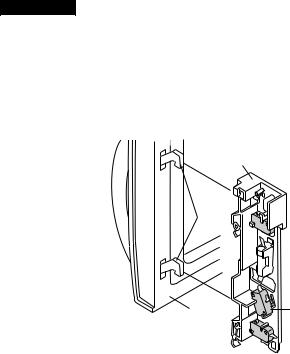
R-1480
R-1481
R-1482
DESCRIPTION AND FUNCTION OF COMPONENTS
DOOR OPEN MECHANISM
The door is opened by pulling the door handle, refer to the Figure D-1.
Latch
Hook
Latch
Heads
 Door
Door
Sensing
Switch

 Monitor
Monitor
Fuse
Door |
Monitor |
|
Switch |

 Secondary
Secondary
Interlock
Switch
Figure D-1. Door Open Mechanism
CAUTION: BEFORE REPLACING A BLOWN MONITOR FUSE TEST THE DOOR SENSING SWITCH, PRIMARY INTERLOCK RELAY (RY2), SECONDARY INTERLOCK SWITCH AND MONITOR SWITCH FOR PROPER OPERATION. (REFER TO CHAPTER "TEST PROCEDURE").
NOTE: MONITOR FUSE AND SWITCH ARE REPLACED AS AN ASSEMBLY
TEMPERATURE FUSE (MG)
The temperature fuse located near the waveguide is designed to prevent damage to the magnetron if an over heated condition develops in the tube due to cooling fan failure, obstructed air guide, dirty or blocked air intake, etc. Under normal operation, the temperature fuse remains closed. However, the temperature fuse will open at 302˚F (150˚C) causing the oven to shut down.
THERMAL CUT-OUT (HOOD )
DOOR SENSING AND SECONDARY INTERLOCK SWITCHES
The secondary interlock switch is mounted in the lower position of the latch hook and the door sensing switch in the primary interlock system is mounted in the upper position of the latch hook. They are activated by the latch heads on the door. When the door is opened, the switches interrupt the circuit to all components. A cook cycle cannot take place until the door is firmly closed thereby activating both interlock switches. The primary interlock system consists of the door sensing switch and primary interlock relay located on the control circuit board.
MONITOR SWITCH
The monitor switch is activated (the contacts opened) by the latch head on the door while the door is closed. The switch is intended to render the oven inoperative by means of blowing the monitor fuse when the contacts of the primary interlock relay (RY2) and secondary interlock switch fail to open when the door is opened.
Functions:
1.When the door is opened, the monitor switch contact close (to the ON condition) due to their being normally closed. At this time the primary interlock relay (RY2) and secondary interlock switch are in the OFF condition (contacts open) due to their being normally open contact switches. And the contacts of relay (RY1) are in the ON condition (contacts close).
2.As the door goes to a closed position, the monitor switch contacts are first opened and then the door sensing switch and the secondary interlock switch contacts close. (On opening the door, each of these switches operate inversely.)
3.If the door is opened, and the primary interlock relay (RY2) and secondary interlock switch contacts fail to open, the monitor fuse blows simultaneously with closing of the monitor switch contacts.
This thermal cut-out located on the right base plate. It is designed to automatically turn on the hood fan motor whenever the hot air rising from the conventional range below causes the temperature at the thermal cut-out to rise to 140˚F (60˚C) or higher, thus removing this hot air from around microwave oven. When the temperature around the thermal cut-out drops to 113˚F (45˚C) or lower, the thermal cut-out shuts off the hood fan motor.
THERMAL CUT-OUT (CAVITY )
This thermal cut-out is located on the top of the oven cavity. It is designed to prevent damage to the oven unit if the food in the oven catches fire due to overheating produced by improper setting of cooking time or failure of control unit.
Under normal operation, the thermal cut-out remains closed. However, the thermal cut-out will open at 293˚F (145˚C) causing the oven to shut down.
TURNTABLE MOTOR
The turntable motor rotates the turntable located on the bottom of the oven cavity, so that the foods on the turntable cook evenly during cooking. Turntable will turn in either direction. The turntable motor can be turned off by touching TURNTABLE ON/OFF pad.
COOLING FAN MOTOR
The cooling fan motor drives a blade which draws external cool air. This cool air is directed through the air vanes surrounding the magnetron and cools the magnetron. This air is channelled through the oven cavity to remove steam and vapors given off from the heating foods. It is then exhausted through the exhausting air vents at the oven cavity.
HOOD FAN MOTOR
The hood fan motor is a two-speed, single-phase, double pole induction type, requiring a hood fan capacitor. It is located outside the upper rear part of the oven cavity, is to remove, from around the oven, hot air rising from the conventional electric or gas range over which it is installed.
10

This air is then expelled either vertically or horizontally through the customer supplied duct system, or discharged back into the kitchen.
STIRRER MOTOR
The stirrer motor drives the stirrer fan to stir the microwave radiation from the waveguide.
R-1480
R-1481
R-1482
HOOD LAMP
The hood lamps are mounted at the hood lamp angle on the base cover. The hood lamps can be turned off and on by touching the WORK LIGHT pad or the NIGHT LIGHT pad. And also the brightness can be varied to high or low by touching the WORK LIGHT pad or the NIGHT LIGHT pad.
TROUBLESHOOTING GUIDE
Never touch any part in the circuit with your hand or an uninsulated tool while the power supply is connected.
When troubleshooting the microwave oven, it is helpful to follow the Sequence of Operation in performing the checks. Many of the possible causes of trouble will require that a specific test be performed. These tests are given a procedure letter which will be found in the "Test Procedure "section.
IMPORTANT: If the oven becomes inoperative because of a blown monitor fuse, check the monitor switch, relay (RY1) primary interlock relay (RY2), door sensing switch and secondary interlock switch before replacing the monitor fuse. If monitor fuse is replaced, the monitor switch must also be replaced. Use part FFS-BA016/ KiT as an assembly.
IMPORTANT: Whenever troubleshooting is performed with the power supply cord disconnected. It may in, some cases, be necessary to connect the power supply cord after the outer case has been removed, in this event,
1.Disconnect the power supply cord, and then remove outer case.
2.Open the door and block it open.
3.Discharge high voltage capacitor.
4.Disconnect the leads to the primary of the power transformer.
5.Ensure that the leads remain isolated from other components and oven chassis by using insulation tape.
6.After that procedure, reconnect the power supply cord.
When the testing is completed
1.Disconnect the power supply cord, and then remove outer case.
2.Open the door and block it open.
3.Discharge high voltage capacitor.
4.Reconnect the leads to the primary of the power transformer.
5.Reinstall the outer case (cabinet).
6.Reconnect the power supply cord after the outer case is installed.
7.Run the oven and check all functions.
11
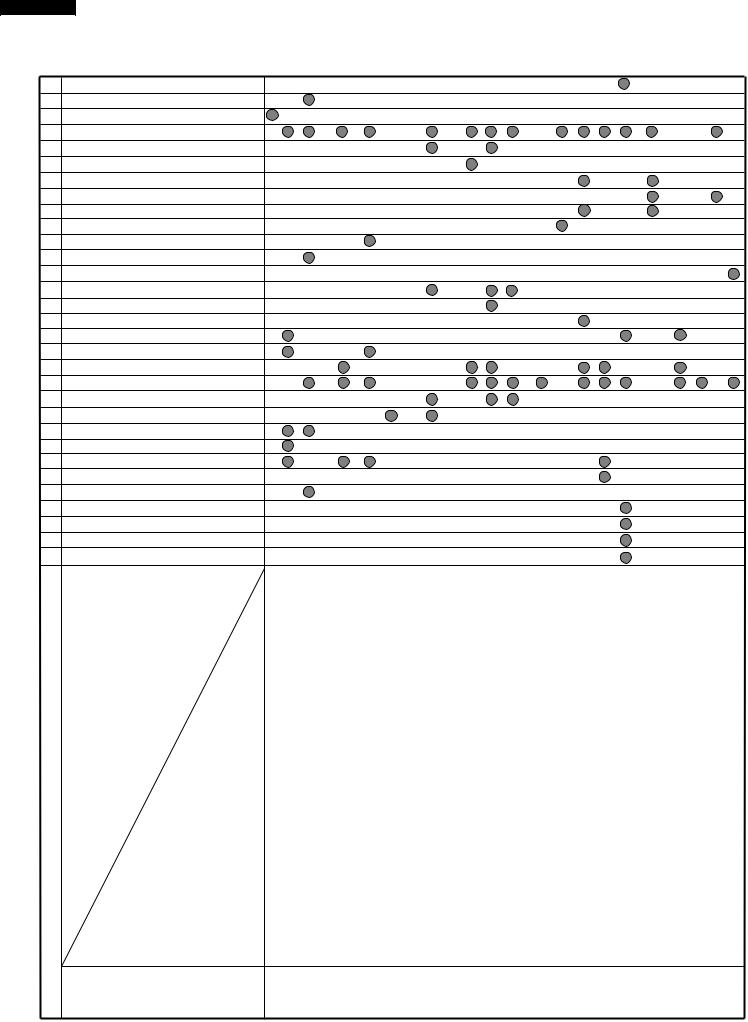
R-1480
R-1481
R-1482
CK |
LOW VOLTAGE |
CK |
NO POWER AT OUTLET |
RE |
SHORTED IN POWER CORD |
CK |
OPENED OR SHORTED WIRING |
CK |
HOOD MOTOR CAPACITOR |
RE |
HOOD LAMP OR SOCKET |
CK |
TURNTABLE OFF CONDITION |
RE |
STIRRER MOTOR |
RE |
TURNTABLE MOTOR |
RE |
FAN MOTOR |
RE |
OVEN LAMP OR SOCKET |
P |
FOIL PATERN ON P.W.B. |
O |
COMPU DEFROST |
N |
RELAY (RY-5) |
N |
RELAY (RY-4) |
N |
RELAY (RY-3) |
N |
RELAY (RY-2) |
N |
RELAY (RY-1) |
M |
KEY UNIT |
L |
CONTROL UNIT |
K |
HOOD FAN MOTOR |
J |
HOOD HERMAL CUT-OUT |
I |
MONITOR FUSE |
H |
MONITOR SWITCH |
G |
PRIMARY INTERLOCK SYSTEM |
F |
SECONDARY INTERLOCK SWITCH |
E TEMPERATURE FUSE OR THERMAL CUT-OUT |
|
D |
HIGH VOLTAGE CAPACITOR |
C |
H.V. RECTIFIER |
B |
POWER TRANSFORMER |
A |
MAGNETRON |
POSSIBLE CASE AND
DEFECTIVE PARTS
TEST PROCEDURE
PROBLEM
CONDITION
CK = Check / RE = Replace
Home fuse blows when power cord is plugged into wall receptacle. |
Monitor fuse blows when power cord is plugged into wall receptacle. |
Display does not illuminate when power cord is first plugged into wall receptacle. |
Display does not operate properly when STOP/CLEAR key is touched. (The time of day should appear on the display with beep sound during normal condition.) |
|
Oven lamp does not light with door is opened. |
Hood fan motor operates when power cord is first plugged into wall receptacle. |
Temperature of oven base seems more than 140˚F (60˚C) because of operation of the range below. But hood fan motor does not turn on automatically. (Normally, food fan motor should be operating at low speed.) |
Hood lights do not turn on when WORK LIGHT pad or NIGHT LIGHT pad is pressed. |
|
Hood fan motor does not rotate at all with touched FAN HI/LO pad. |
Speed of the hood fan motor does not change when the FAN HI/LO pad is touched for this function. |
Oven lamp does not light in cook cycle. (But it does light when door is opened.) |
Fan motor does not operate. (Oven lamp and turntable motor operate.) |
Turntable motor does not operate (Oven lamp lights and fan motor operate.) |
Oven does not go into cook cycle when START pad is touched |
Oven seems to be operating but little or no heat is produced in oven load. |
(Food incompletely cooked or not cooked at all at end of cook cycle.) |
Oven goes into a cook cycle but extremely uneven heating is produced in oven load (food). |
Variable cooking does not operate properly except Cooking Power 10 (P- HI) mode. |
Function of COMPU DEFROST does not operate properly. |
Stirrer motor does not operate. (Other parts operate.) |
Oven goes into COMPU DEFROST but food is not defrosted well. |
|
|
|
|
|
|
|
|
|
|
|
|
|
|
|
|
|
|
|
|
|
|
|
|
|
|
OFF CONDITION |
|
|
|
IDLE |
CONDITION |
|
|
|
|
|
MICROWAVE COOKING |
CONDITION |
|||||||
|
|
|
|
|
|
|
|
|
|
|
|
|
|
|
|
|
|
|
|
|
|
|
12
